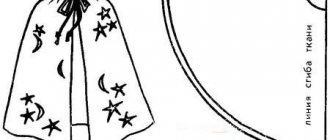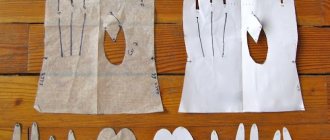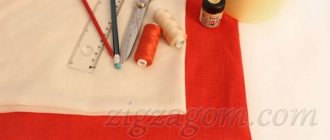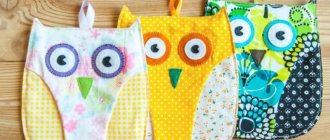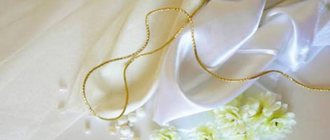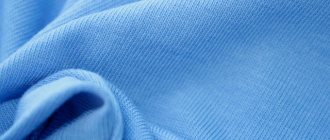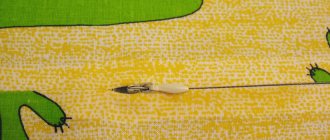Models
In the photo, beach outfits are shown by girls with slender figures. Before you start sewing the model you like, try it on in the store.
The following swimsuit models are distinguished:
- Bikini. An option for the perfect figure, as this type of beach outfit is designed to show off, not hide. This is a light bust with thin straps and small panties.
- Bando. Translated from French - “ribbon”. The bodice is made in the form of a bandage. The bottom of the swimsuit is a thong, classic swimming trunks or high panties that correct the waistline and hide the belly. This model looks good on girls with small breasts and visually enlarges them.
- Tankini. Classic swimming trunks and a T-shirt top. Not recommended for girls with an apple figure, as the shirt will ride up.
- Halter. Slightly enhanced bikini. It has ties at the neck that can support even large breasts.
- Mayo and tank. Little-known names of classic one-piece, closed swimsuits with sewn or one-piece straps, respectively.
- Monokini. A one-piece, but maximally open suit, in which the upper and lower parts are connected by small inserts of fabric.
The bodice is additionally reinforced with soft liners or frames. And the finished outfit is complemented with accessories: beads, rhinestones, decorative rings.
How to sew swimwear
If everything is quite complicated with a monokini, then the answer to the question of whether it is possible to sew up swimsuit briefs at home is much easier to find. And here there are possible options.
Swimming trunks can be sewn in different ways
There is a way to make panties smaller. This method will take a minimum amount of time and effort. It will not only make the bottoms a little more compact, but will also decorate them in the back, making the bikini much more original and modern. To complete the work you will need:
- Find the middle of the back of your swimming trunks as accurately as possible.
- Using soap or tailor's chalk, draw a line 10 to 15 cm long (depending on the original size of the swim panties).
- Gather the fabric along the marked line onto the thread. The thread should be chosen to match the color of the swimming trunks and be strong enough.
- Gather the fabric.
- Fasten the thread.
Gathering at the back is the easiest way to renovate swimwear.
Important! Using this technique, you need to go through the thread in both directions several times (and also fasten it several times). If you ignore this recommendation, there is a high probability that the thread will simply not hold up and will unravel right on the person.
The advantage of suturing in the manner described is that neither the gusset nor the side seams are touched or cut. This means that in case of weight gain, everything can be returned to normal in a matter of seconds, literally according to the principle of “one leg here, the other there.” All you need to do is remove the threads.
Another option for sewing swimsuit briefs involves cutting them on the sides and cutting off excess fabric. In this case, it is important to do everything carefully and do not forget to carefully process the seams when re-stitching.
You can also use a more interesting life hack, which is also perfect for implementing at home. The work ahead is not the most difficult:
- rip the panties apart at the side seams;
- bend it in such a way that a kind of drawstring is formed;
- insert strings into the drawstrings;
- tie the ropes.
If the bodice is on strings, it will look great. And the alteration itself is so simple and uncomplicated that even a small child can easily handle it.
You can not only buy ready-made swim panties with ruffles, but you can also make them yourself
For those who don’t like dangling strings on their swimming trunks, you can form small neat bows, hem them and secure them with belt loops or buckles.
You might be interested in: How to properly sew dresses at home yourself
Important! When sewing panties in a fly, if necessary, an important condition must be observed: suturing should be done as carefully as possible. Otherwise, it will be uncomfortable to walk. It is especially important to sew the gusset tightly.
Fabric selection
Criterias of choice:
- elasticity;
- resistance to light, salt and chemicals;
- density, ability to hold shape;
- hygiene;
- hygroscopicity.
Also, the fabric must be hypoallergenic.
A swimsuit made of natural fabric shrinks, does not hold its shape well, fades in the sun and quickly loses its aesthetic appearance due to the action of chlorine.
Let's look at the main synthetic fabrics in the table.
| Fabric name | pros | Minuses |
| Polyester | Protects from ultraviolet radiation | Electrified |
| Has water-repellent properties | Takes a long time to dry | |
| Resistant to various types of pollution and proliferation of microorganisms | Does not allow air to pass through, “does not breathe” | |
| Retains color | Requires gentle washing without spinning | |
| Polyamide | Repels moisture | Doesn't wash well |
| Prevents the growth of bacteria | Does not tolerate heat above 40°C | |
| Doesn't fade, doesn't fade | Gentle wash without spin | |
| Durable but lightweight | ||
| Lycra (elastane, spandex) | Elastic | Synthetic fiber |
| Lightweight and durable | ||
| Rarely used in its pure form | ||
| Moisture resistant | ||
| Keeps its shape and does not wrinkle | ||
| May cause an allergic reaction | ||
| Hygienic | ||
| Permanent color | ||
| Microfiber | Allows air to pass through | May lose shape without elastane |
| Dries quickly | ||
| Pleasant to the body, hypoallergenic | ||
| Supplex, sports jersey | Durable | More expensive than other fabrics |
| Resistant to abrasion, sun and chemicals | ||
| Waterproof, dries quickly | ||
| Allows air to pass through | ||
| Elastic |
The best fabrics for sewing a swimsuit are lycra, microfiber and supplex. A beach outfit made from these materials will be durable and easy to care for.
Consumables
Before sewing a swimsuit with your own hands, you need to prepare the following tools and materials:
- Sewing machine;
- Thin needles, preferably special needles for delicate fabrics;
- Threads to match the fabric for sewing and contrasting ones for basting stitches;
- Centimeter and ruler;
- Scissors. It is very important that they are very sharp. Dull blades can leave marks on thin artificial fabric;
- Rings
- Ready-made cups for bodice or bones
- Straps
- Strap adjusters
- Linen fasteners.
Sewing technology
The process of sewing clothes consists of:
- cutting fabric;
- connection of elements;
- decorative finishing.
Manufacturers develop separate patterns for each model and size of swimsuit.
When working independently, the process is simplified as much as possible. The use of elastic fabrics makes cutting easier. Basic tricks of home cutting:
- Trace according to the example. Take the soft bra cup pads, place them on the fabric and trace around them, adding a seam allowance. Cut the bottom according to the panties.
- By eye. The bikini top is cut from two triangles. It is enough to roughly calculate the width of the mammary glands, their height and draw a suitable triangle.
- Bandeau without cut. This fashionable swimsuit requires no tailoring at all. It is enough just to cut one or two strips of fabric around the circumference of the chest and combine them into the finished product.
- According to the pattern. Find them in fashion magazines at the beginning of the season or on the Internet. To design one-piece suits, the dress pattern is used as a basis.
It is better to cut children's swimsuits by outlining the child's underwear: panties and a T-shirt.
How to sew a one-piece swimsuit
There are often cases when not only the owner of a swimsuit changes her size to a smaller one, but the item of clothing itself stretches. If we are talking about a one-piece swimsuit, the independent process of altering it is a rather labor-intensive undertaking that requires a certain skill and experience. In most cases, it is best to have it sutured in a studio. Professionals will cope with the task much better, and the risk of damaging the product will be reduced to zero.
A one-piece monokini is easiest to sew on the sides
If you still want to try to reduce the size of a closed swimsuit on your own, the most advisable way to do it is as follows.
- Take any old similar swimsuit that fits perfectly.
- Rip it apart at the seams.
- Do the same with a new swimsuit that you plan to make smaller.
- Place one piece (front or back) of the swimsuit to be altered on a flat surface.
- Place the same detail of the sample swimsuit on top.
- Pin both swimsuits together.
- Trim off excess fabric.
- Do the same with the second part.
- Sweep open seams.
- Try on the product.
- If everything fits, stitch the front and back of the swimsuit together.
- Finish seams with overlock or zigzag.
This method is applicable because a one-piece swimsuit does not have such a detail as an armpit. Otherwise, much more effort would be required.
Some monokini models are quite problematic to sew on your own
Important! You should not try to make a woman's swimsuit smaller by contrast washing or boiling. It is sewn from elastic synthetic fabric. And this method will not work with him.
You may be interested in How to sew a patch pocket to a knitted item or bag
Separate swimsuit pattern
There is nothing complicated in creating a two-piece swimsuit pattern. First, a silhouette is made with the dimensions of the bottom. Two triangles are created and a spacer between them. Then the silhouette of the top is made. As a rule, it already includes such important parts as the back and fastening. In order not to make mistakes in calculations, you can use one of the ready-made patterns in the articles called sewing a swimsuit.
You might be interested in Easy and simple patterns for dressing gowns: we sew them ourselves
Separate model pattern diagram
How to sew a swimsuit with your own hands: patterns and step-by-step master class
Materials and tools
First you need to collect everything you need so as not to miss anything:
- 1 meter of stretch synthetic fabric in your favorite color;
- centimeter to measure your body,
- scissors,
- paper and pen for cutting templates and patterns.
Patterns for swimsuits
We will sew a swimsuit using this pattern:
You can use other options. For example, this pattern for a two-piece swimsuit with high panties:
Or here’s a template for sewing a one-piece swimsuit:
How to use patterns? The values are based on personal measurements, so it is important to measure yourself and enter your dimensions into the diagram.
The following measurements are taken:
- chest circumference under the chest;
- width of the breast, measured through the center of the chest along the nipple halo;
- the desired height of the cups of the swimsuit bodice, measurement is also made through the center of the chest or the halo;
- hip girth;
- saddle depth, measurement extends from the area just below the navel to the coccyx through the groin area.
Add 1 cm on all sides of each part, measure and cut out the swimsuit pattern. We transfer the resulting template to the fabric, draw the borders and cut it out.
Swimsuit for curvy ladies
If everything is clear with swimsuits of standard sizes, it is enough to find a swimsuit model in your size, but finding a beautiful large size swimsuit is sometimes very difficult. Therefore, it is worth thinking about sewing a swimsuit with your own hands.
It is better to choose fabric for such a swimsuit from fabrics with a stretch effect. High-waisted panties also look good, making your figure more proportional. Wide straps will better support the top of the swimsuit. When sewing a large size swimsuit, you should adhere to several rules:
- To make the top of a two-piece swimsuit look more interesting, gather the fabric between the cups into decorative folds;
- To prevent the straps from cutting into your shoulders and to make the swimsuit look proportional, make them wide enough;
- When sewing panties, leave at least three centimeters for the elastic insert;
- Do not tuck the leg openings, otherwise they will rub against fuller thighs;
How to take measurements
As for taking measurements, you will need to know the chest circumference with the hip circumference using any step-by-step instructions from the master class. You also need to have an idea of the width of the back and the height of the chest, namely the vertical distance from the top of the cups to the bottom. To create a closed type of product for pregnant and overweight ladies, you will also need to know your waist size.
To take measurements correctly, even from a doll, it is necessary to take measurements without underwear, ideally. If this is not possible, you need to measure with a bra without push-up. Measurements should be based on the body. Skirt allowances should not be left, since the future swimsuit should fit tightly to the body.
You might be interested in this: Making a pattern and sewing pockets for a locker in a kindergarten
Note! To ensure accurate measurements, it is better to take an elastic band rather than a simple centimeter.
Taking measurements

